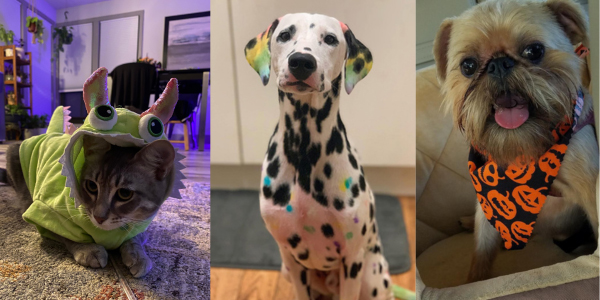 In the United States, Halloween is a widely celebrated tradition loved for its excitement and energy and for the creative outlet it allows for all those who participate.
In the United States, Halloween is a widely celebrated tradition loved for its excitement and energy and for the creative outlet it allows for all those who participate.
Nowadays, the fun of dressing up in costumes extends to our dogs and cats, too!
But before you jump into the world of pet costumes and fur dye for Halloween, there are important questions to consider.
Is it okay for you to use dye on your pet's fur? Is pet fur dye safe? What about different pet costumes? And what costume features should be avoided for safety?
With so many pet costumes and fur dyes on the market, it can be hard to tell what's safe to use on your pet.
While it may be OK to do this with some cats or dogs (who have the right disposition) and with certain products — coloring your pet's fur or making them wear a costume isn't always the best idea.
In many cases, it can cause your pet discomfort or distress. And in some cases, it can actually lead to significant health and safety problems.
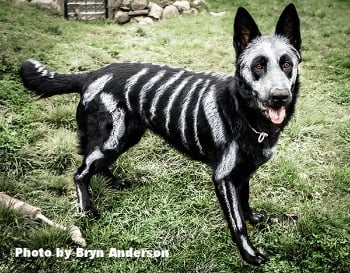 The dog featured in the photo here is that of Bryn Anderson, a Washington-based artist, who in 2014 posted photos of Nixe (who now has her own Facebook page) painted as a skeleton.
The dog featured in the photo here is that of Bryn Anderson, a Washington-based artist, who in 2014 posted photos of Nixe (who now has her own Facebook page) painted as a skeleton.
She got lots of positive comments, but many people were concerned about Nixe's safety.
Fortunately, as Ms. Anderson points out repeatedly, she used non-toxic face paint to turn Nixe into a "skeleton dog" and took many other precautions, too.
She also reassured viewers, and as her pictures seem to support, that Nixe is a very relaxed dog who wasn't bothered by the painting process.
While I understand why you might want to decorate or dress up your pets in a similar fashion, do keep in mind that Nixe (and other pets like her) tend to be the exception, rather than the rule, when it comes to being painted or dyed.
These decorative flairs are often more fun for us than they are for our pets, so please consider these few tips below should you get the urge to paint your pet.
Safety Tips For Dyeing Your Pet's Fur at Home
- Use pet-safe paint: If you decide to use it, test it first on an easily washed part of your pet and monitor closely for any bad reactions (redness, swelling, hives, itching, breathing issues). If you plan on making your own homemade pigments to paint with, please beware of their potential toxicity. See tips #3 and #7 below.
- Consider your pet's tolerance and stress levels: Some dogs and cats love the attention they receive during and after their makeover. But, many dogs, and most cats, won't be overly excited about or eager to stand still long enough for you or your groomer to apply a hair coloring product to their coat. Consider doing it in short sessions, keep the intricacy of your design very minimal or basic, or if your pet really doesn't like it, don't put them through it.
- Keep their licking and grooming potential in mind: Any cat or dog, whether stressed by the application process or not, may be tempted to lick the applied color off their coat. Depending on the product applied, this could cause your pet a case of distressing and painful digestive upset or even result in toxicity.
And "all-natural" doesn't always mean "all safe!" See this report of a dog who developed hemolytic anemia (destruction of her red blood cells) after ingesting some "all-natural," henna-containing hair dye. Fortunately, she made a complete recovery with medical treatment. - Beware of unwanted attention from other animals: Depending on the type of product you're using to dye or color your pet's fur, you may even be increasing the amount of attention your pet gets from other animals. Many of the home DIY products people recommend for coloring pet fur are food-based. People advocate using the juice from certain fruits and vegetables (berries, beets, asparagus, and a host of other foods have been suggested), they also recommend using human food grade food colorings, and some even advocate using Kool-Aid® powder.
While some of these may be safer, all will likely attract attention from other animals — leading to unwanted sniffing, licking, and pestering, which will be stressful for your pet and could easily escalate to a fight. Plus, certain insects might find the smell of these food-based dyes enticing, such as bees or wasps. And you don't want your pet getting stung! - Where you apply it is important: If you're going to paint your pet for Halloween or any other festive occasion, make sure to avoid the eyes and mouth areas. Also, if they're lickers (Tip #3), you should keep the paint limited to areas they can't reach, like their back or the top of their head. This doesn't really apply to cats, though, as they can use their paws and seemingly contort to clean pretty much everywhere.
- Avoid irritation and allergies: Anything you put on your pet's skin or coat has the potential to cause irritation and/or a true allergic reaction. This is true whether or not the product is designed and marketed for use on people or pets. It's even the case with the shampoos and conditioners you may use to remove the coloring from your pet's fur. Of course, such reactions are less likely to occur if you use a pet-specific product, but they can (and do) still occur.
- Don't fall for the "what's safe for people is safe for pets" assumption! This assumption couldn't be further from the truth. It's (sadly) a very common assumption, and it's a very dangerous one that can prove debilitating or even fatal to a pet.
Tips and Best Practices for Finding a Groomer to Dye Your Pet's Fur
We reached out to Liz Ross, the grooming specialist at Alta Loma Animal Hospital, and asked her to share some best practices when it comes to selecting a potential groomer to dye your dog or cat's fur. Here are some of the really important tips she shared:
It's Not for Everyone
Dyeing a pet’s fur can be controversial for some, but if done safely and correctly, it can be a fun addition to your pet’s regular grooming that does not cause any additional stress or unnecessary health and safety risks. The most important thing to keep in mind is that not all dogs and cats should have their hair dyed.
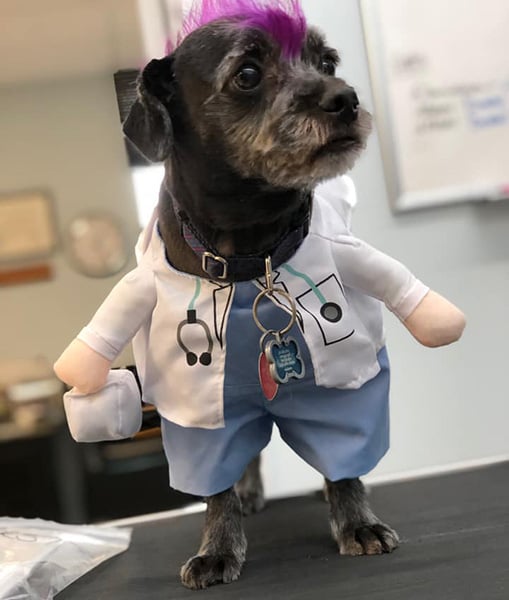
Trust is Important
Not all groomers offer services like hair dye. It takes a lot of patience and skill to groom pets and even more to be able to dye their hair safely. First, find a groomer you trust with your pet’s safety and care.
The groomer should require proof of current vaccines for every pet that comes in. This is for the safety of all the pets in their care. A tour of their facilities should be given if you request it.
The groomer should be confident in their abilities, friendly, and thorough in their evaluation of the pet’s skin, coat, health, temperament, and grooming needs.
The groomer should take the time to answer any questions you might have prior to the groom. It's recommended to ask what kind of additional services the groomer offers, especially if you want your pet's hair dyed.
Some groomers will usually recommend one or two grooming sessions without hair dye. This allows them to evaluate your pet’s temperament and tolerance of being groomed before adding additional services. This is also a good way for the groomer to determine the type of hair dye they would recommend.
What to Ask a Pet Groomer
- Pictures of pets that the groomer has dyed
- What types of hair dye brands they use? And how the groomer knows the products are safe for pets?
- What areas of the body they offer for dyeing? Popular styles are mohawks, ears and tail, or a design on the back hip.
- What dye artistry would they recommend for the dog or cat, and if they feel that the pet would be a good candidate for hair coloring.
A good groomer will not dye hair on a pet that is very young, very old, or has skin issues like allergies, yeast infections, scratches, or sores, is very energetic during grooming, fearful or aggressive.
The groomer should let you know that if your pet becomes upset at any point in the grooming process, then the grooming/hair dye will be stopped. A groomer should not be willing to traumatize a pet in order to achieve the “perfect” look.
The groomer should offer services based on their skill level. This will depend on how long they’ve been dyeing pet hair, what breeds of dogs or cats they have dyed, what they feel comfortable with doing for each individual pet they are grooming, and what products they are knowledgeable and confident in using.
Special Considerations for Cats
When it comes to cat grooming and dyeing their hair, it is important to be aware that their skin is very sensitive. And because cats groom themselves by licking their fur, the dye could be toxic due to their unique metabolism. Therefore, a special type of hair dye must be used for them. This further limits what type of hair dye they can safely receive, as opposed to dog hair dyeing.
Pet-Safe Fur Dye
It's important to be aware that pet products have fewer rules and regulations compared to human products. The brands Liz feels confident in using are Opawz and Crazy Liberty, made specifically for pets. She has used human hair dyes in the past (Arctic Fox and Manic Panic), but it's always best to stick with products that are specifically formulated for pets, especially if you're not a professional groomer.
You may have seen Opawz pet hair dye being used by creative groomer Gabriel Feitosa on the reality competition show Pooch Perfect:
Their products are also very popular among the Dogspotting Facebook group, as you can see on Jag, the beautiful Dalmatian below.
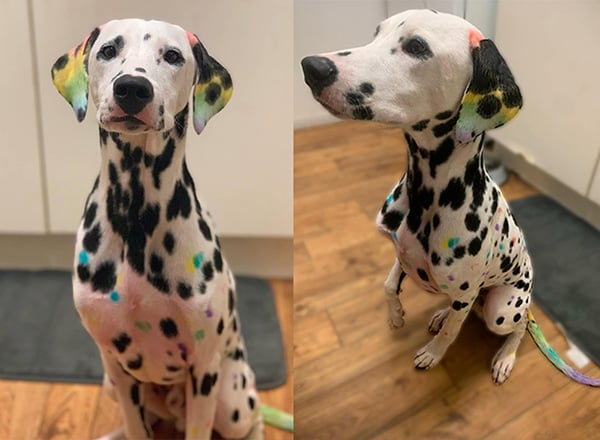
Jag is looking fresh and showing off his colorful side.
Photos courtesy of his mom, Ashlee Polmear.
The pet-safe hair dye your groomer may offer can include temporary hair dye shampoo, semi-permanent color, permanent color, temporary colors like chalk and paint pens, airbrushing, bleach, and cat-safe hair dyes. Each of these products will look different on different types of coats (long or short fur, wire coats, and soft coats) and especially different colors of coats. The darker the coat type, the fewer options there are for dyeing that pet’s hair.
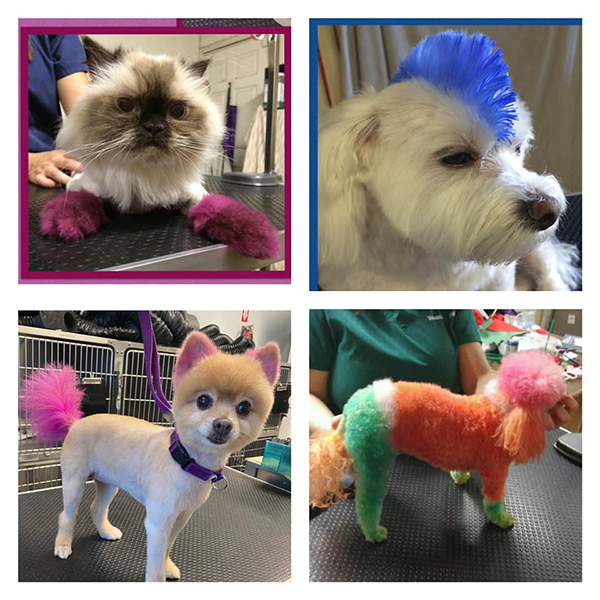
showing off their fur dye jobs.
Be sure to read all the OPAWZ warnings and F.A.Q. and follow the label directions carefully. Cat owners, please note their website states, "Cats have more allergic reactions than dogs and horses because their organs are different. A lot of groomers are new to creative coloring, and we are concerned that they are unable to determine whether the cat will have allergic reactions to the products or not, so we do not recommend it for cats. We recommend using the OPAWZ Semi-Permanent Dyes and Color Shampoos for cats since they have gentler formulas."
The Pet Paint brand claims to be veterinary-approved. Unfortunately, they don't share any of the studies supporting their safety claims, and they don't cite any veterinarians who provide recommendations. We have reached out to them and to Opawz and Crazy Liberty to ask about their pet-safe claims and toxicity reports. When we learn more, we'll post it here.
Don't Rush Into Things
I recommend that all pet parents interested in dyeing their pet's hair, whether done by themselves or a professional, research different brands, consult their pet groomer and veterinarian, and keep in mind that not all pets are good candidates for having their hair dyed.
Keep a close eye on any pet that has had their hair dyed for allergic reactions (although very rare, it still can happen). A patch test should be done with any dye being used to ensure your pet is safe for the brand and product you would like to use.
And lastly, keep it fun for your pet. If the pet is stressed or doesn’t want to cooperate during the hair dye process, then they shouldn’t be forced. The health, safety, and mental well-being of your pet should always be your top priority.
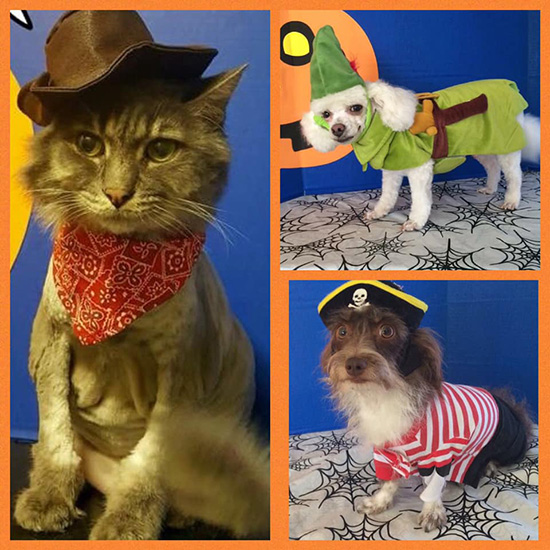
Pets and Costumes
You may have decided, for one reason or another, that dyeing or coloring your pet’s fur isn’t the best route for Halloween (or any other holiday). So, you may be wondering, “What about a pet costume?”
Depending on your pet's personality, event, and the type of costume you’re planning on using, a costume might be a better match for your pet. But, of course, this isn't a one-size-fits-all situation. There are a whole bunch of potential problems to be aware of when it comes to costumes. Many pets are brought into the ER around Halloween because of inappropriate costumes.
Pet Costume Tips
- Supervision: Never leave your pet alone wearing their costume without observation. There are many reasons, such as panic, boredom, or anxiety, that may cause a pet to chew and ingest parts of the costume. They could ingest a piece and suffer from an obstruction or other injury to their gastrointestinal tract.
- Size matters: Be sure to choose a costume that fits right — not too loose, not too tight. If the costume is too tight, especially around the neck, paws, legs, or body, there is a risk of injury due to pets panicking because of the tight pressure on their body.
Additionally, if any part of the body is pinched due to elastic or velcro being too tight, swelling and discomfort can occur.
Be sure that the costume doesn't obstruct your pet's mobility, vision, hearing, or breathing (especially flat-faced breeds).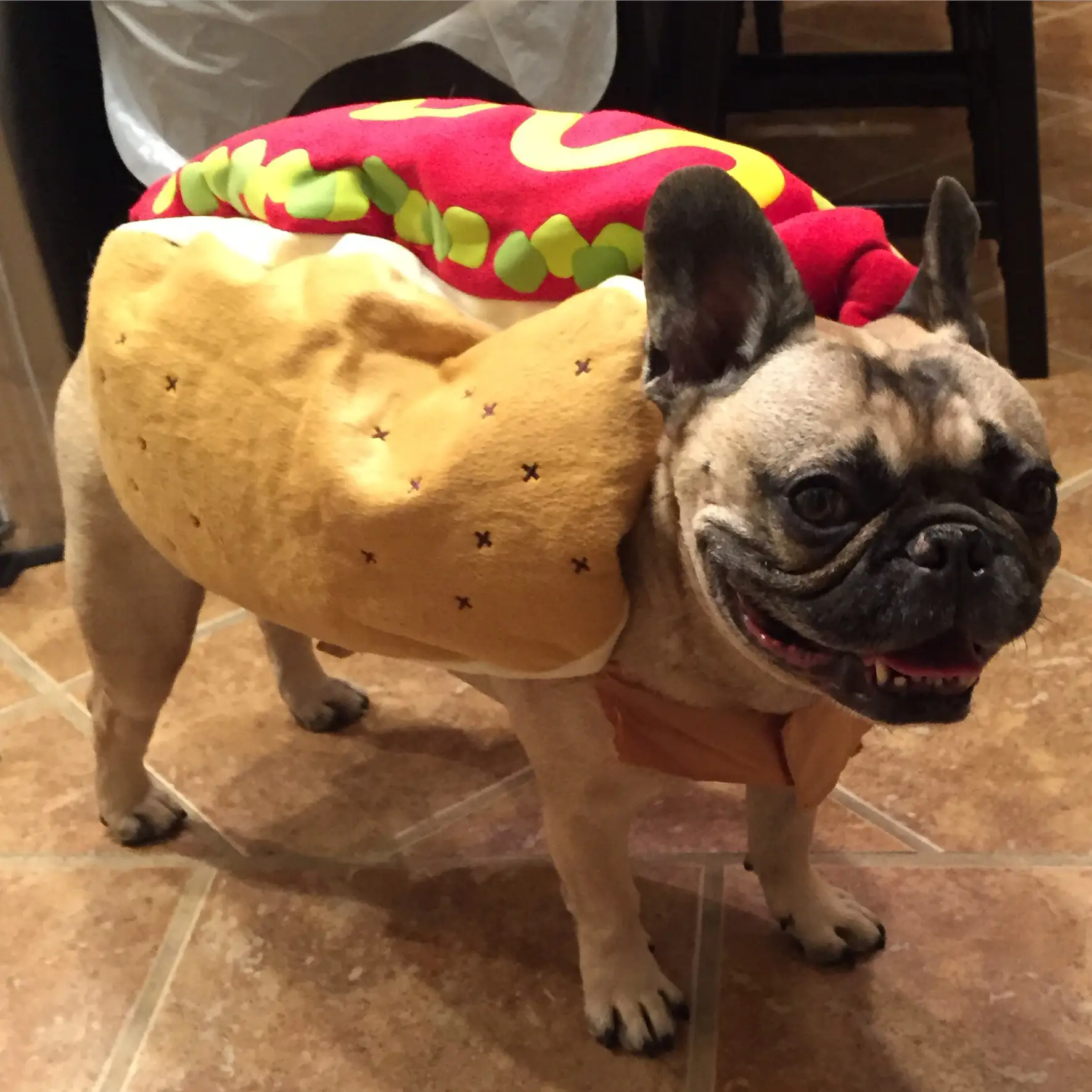
For some reason this hot dog costume is the only thing Marshall the Frenchie loved to wear. He sure looked cute in it!
Note: Be sure when selecting a costume that your pet can easily use the bathroom without interference or soiling the costume.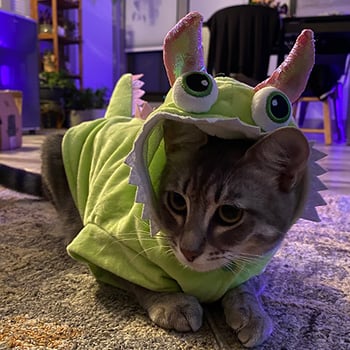
- Avoid dangles and bling: Avoid costumes with dangling pieces of fabric, bells, strings, ornaments, bows, or other decorative pieces that could easily trip up your pet or find their way into your pet's stomach. No one wants to spend Halloween night in the animal emergency hospital.
- Acclimation: Take the time (and LOTS of it) to get your pet used to their new costume. Put it on one piece at a time to let them acclimate and give them plenty of love and treats to make it a fun and rewarding experience. Start with having them wear it for a very short amount of time, building up that duration with practice.
But always follow your pet's lead — if the whole dress-up process is stressing them out, just don't do it. If they freeze and refuse to move or make an effort to get the costume off, immediately remove it.
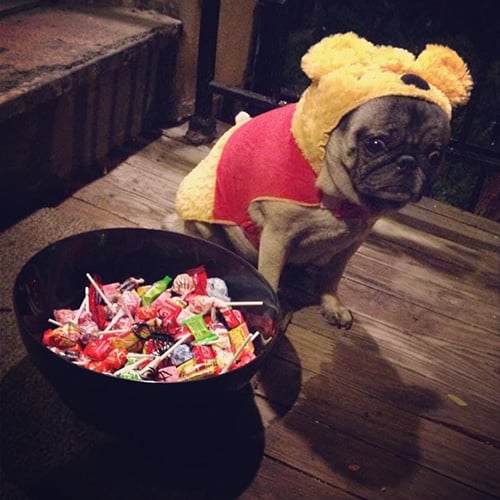
Minnie Pearl, the pug in her Winnie the Pooh costume, standing guard at the trick-or-treat station. Don't worry, she wasn't going through an existential crisis, and she was totally comfortable — that's just her face. - Watch the weather: Depending on where you live, the weather at Halloween can be cold, warm, and/or wet. Costumes can cause pets to overheat if the weather is warm. This can result in heat stress. Be sure to closely monitor that your pet isn’t getting too warm (excessive panting, difficulty breathing, drooling, weakness, abnormal heart rate).
Rain can cause the dye in costumes to run, which can result in irritation to your pet’s skin or, even worse, an allergic reaction. Additionally, rain can damage the costume structure resulting in it collapsing and potentially blocking your pet’s vision, hearing, or breathing. If the weather isn’t optimal, don't dress your dog up. - Allergies: It is possible for pets to have allergic reactions to Halloween costumes. A reaction can be caused by the type of fabric, chemical additives used in the processing of the fabric, hidden dust mites, or what it may have been cleaned with (detergent and/or fabric softener).
Monitor your pet for any itching or breathing issues while wearing the costume. If you notice any type of allergic reaction (rash or hives), remove the costume immediately and contact your veterinarian. - Proper ID: Just like people should always have proper identification with them, so should your pet. Your pet’s identification should always be clearly visible, no matter what type of costume they are wearing. Even if your pet isn’t going out trick-or-treating, be sure they have some type of ID on them in case they bolt out the door when trick-or-treats arrive.
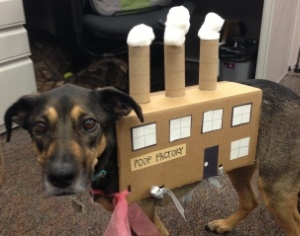 For a fun costume idea, check out Ellie on parade as a "poop factory." This costume is fun, imaginative, and safe (the cotton balls were glued in).
For a fun costume idea, check out Ellie on parade as a "poop factory." This costume is fun, imaginative, and safe (the cotton balls were glued in).
Ellie may be looking a little timid posing for this picture, but she truly wasn't phased by her costume, and she certainly had no trouble getting around and visiting all her friends! And, of course, she was never left unattended while wearing it.
DIY costumes are becoming more and more popular with pet parents and are a great way to be creative while saving a little money!
And remember, you don't have to be over-the-top in order to be festive. Sometimes, a themed shirt, bandana, or ruff collar is all that's needed to be the life of the party. But be sure never to leave them unsupervised when in costume, even one as simple as a bandana.
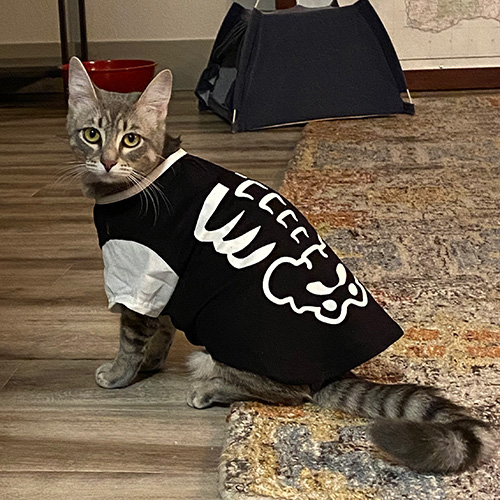
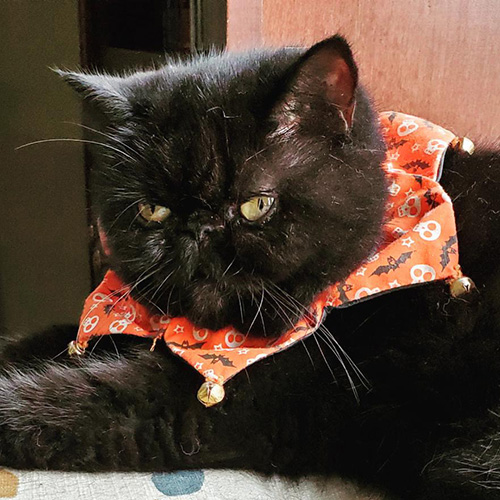
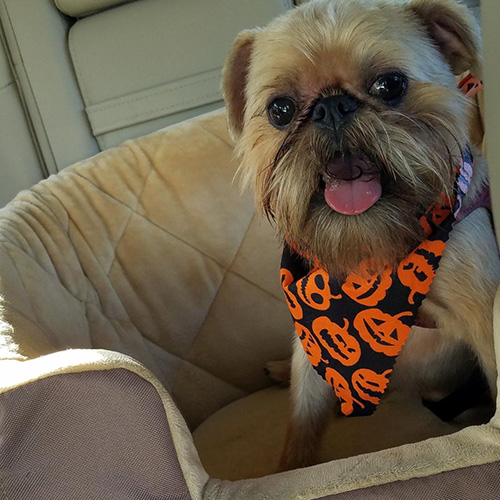
Done right, costumes can be a fun time, and they can make for some adorable pictures. Done wrong, though, they can result in a multitude of problems.


